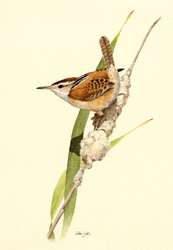Breeding Bird Atlases (BBA)
Find a Bird - BBA1
Breeding Bird Atlas 1 Species Accounts
Marsh Wren
Cistothorus palustris
Egg Dates
May 27 to August 1
Number of Broods
one or two

The Marsh Wren is a common but local summer resident of various wetland habitats. Inland populations are associated with extensive cattail marshes along major river valleys. On the coast, this species is found in the marsh grasses bordering tidal creeks and in the sedge or rush growth of brackish marshes. One of the best descriptions of the habitat affinities of this species was given by Forbush, who called the Marsh Wren a bird of the “oozy slough.”
During the Atlas period, breeding was confirmed in 9 of the state’s 14 counties, with the preponderance of records in eastern Massachusetts. In recent years in Worcester County, Marsh Wrens have declined in the Quaboag River marshes, a former stronghold, and are rare along the Still River in Bolton.
Bent described the vegetation for four different habitats in which Marsh Wrens nest in Massachusetts. In large freshwater marshes, the dominant plants are Broad-leaved and Narrow-leaved cattails, bulrush, sedge, Wild Rice, and Buttonbush. Along tidal riverbanks, the birds inhabit tall reeds and marsh grass, and the wrens sometimes utilize zones of pure Wild Rice along some inland rivers. In another type of marsh, particularly in Essex County, the characteristic flora is a mixture of bulrush, horsetail, Sweet Flag, bluejoint, and Reed Canary-grass.
The first males typically arrive on their breeding grounds in early May, but the bulk of the population does not appear until late in the month. The birds soon begin to establish nesting territories through various visual and vocal displays. Males may also at this time begin to build the dummy nests for which the species is noted. Some males are polygamous and must defend a large territory to accommodate the females, which will not tolerate one another in their own smaller territories. Marsh Wrens assemble in loose colonies and where sufficient habitat exists can occur in sizable numbers.
The reedy song of the Marsh Wren matches its chosen habitat. Several introductory rasping chips are followed quickly by an extended and rapid rattle. Although this performance is often given from dense cover, the male also performs fairly spectacular, though brief, vocal flights above the nesting area. These aerial displays typify the exuberant energy of this species. Several call notes are given, including a low tchuck-tchuck and a scolding chatter. Courting males puff up their feathers, cock the tail, and quiver the wings.
The female Marsh Wren builds the active or brood nest, usually among cattail flags (typically the new green ones), sedges, or rushes from 1 to 3 feet above the water. The somewhat elongated woven structure, between 6 and 8 inches high, with a diameter of approximately 3 inches, is hitched to two or more plant stems. Various materials, including cattails and marsh grasses, are used for construction, and cattail down or feathers form the lining. A side hole provides access to the nest. A female in Bolton was recorded constructing a nest one foot above the water in cattails on May 30. The male sang and followed her while she worked (Meservey). In Rowley, a male was observed building a nest on June 19 at a height of about three feet in Purple Loosestrife stalks (CNR).
Five or six eggs form a typical clutch, but up to ten have been recorded. Incubation is by the female alone for 13 to 14 days, and the young fledge after a similar period of time. While the male may assist in feeding the young, only the female broods them. No specific data on young is available for Massachusetts. The period from egg laying to fledging in Essex County is listed as the second week of June to the second week of August (ECOC). The extended range of egg dates would allow for two broods. However, flooding along rivers during June can cause heavy losses of both eggs and young.
Marsh Wrens often remain in and near their nesting habitats throughout September and into October. While most members of the population migrate south to Gulf Coast and Mexican wintering grounds, a few birds attempt to overwinter in the north, particularly in the southeastern Massachusetts coastal marshes.
Map Legend and Data Summary
Atlas 1 data collected from 1975-1979


Note: locally common in areas of extensive cattails; very local and uncommon inland
Richard K. Walton



